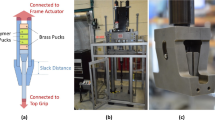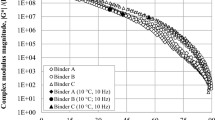Abstract
The article reports experiments using the Taylor test to define the dynamic behavior of brass. This material does not exhibit strain rate dependency therefore it allows the validation of an analytical description of flow stress as a function of strain with strain hardening for the data obtained from the Taylor test. The experiment is used to study the process of damage and fracture with fragmentation which is dependent on the impact velocity. Using the experimental data a numerical model of the Taylor test is developed to determine the strain level and the strain gradient along the specimen.
Similar content being viewed by others
References
Nussbaum, J., and Faderla, N., “Evaluation of Strength Model Parameters from Taylor Impact Tests,” Procedia Engineering 10: 3453–3458 (2011).
Xiao, X., Zhang, W., Wei, G., Mu, Z., and Guo, Z., “Experimental and Numerical Investigation on the Deformation and Failure Behavior in the Taylor Test,” Materials and Design 32: 2663–2674 (2011).
Wang, B., Zhang, J., and Lub, G., “Taylor Impact Test for Ductile Porousmaterials—Part 2: Experiments,” International Journal of Impact Engineering 28: 499–511 (2003).
Xiao, X., Zhang, W., Wei, G., and Mu, Z., “Effect of Projectile Hardness on Deformation and Fracture Behavior in the Taylor Impact Test,” Materials and Design 31: 4913–4920 (2010).
Couque, H. “On the Use of the Symmetric Taylor Test to Evaluate Dynamic Ductile Compression Fracture Properties of Metals,” Proceedings of the 5th International Conference on Structures Under Shock and Impact, Computational Mechanics Inc, Billerica, MA, USA (1998).
Jankowiak, T., Rusinek, A., and Lodygowski, T., “Validation of the Klepaczko–Malinowski Model for Friction Correction and Recommendations on Split Hopkinson Pressure Bar,” Finite Elements in Analysis and Design 47: 1191–1208 (2011).
Iwamoto, T., and Yokoyama, T., “Effects of Radial Inertia and End Friction in Specimen Geometry in Split Hopkinson Pressure Bar Tests: A Computational Study,” Mechanics of Materials 51: 97–109 (2012).
Rusinek, A., and Zaera, R., “Finite Element Simulation of Steel Ring Fragmentation Under Radial Expansion,” International Journal of Solids and Structures 44: 5611–5634 (2007).
W.J. Phillips, Engineering Design Handbook—Sabot Technology Engineering, US Government Agency, Washington, DC (1972), 2–4.
Taylor, G., “The Use of Flat-Ended Projectiles for Determining Dynamic Yield Stress I,” Theoretical Considerations. Proceedings of the Royal Society of London. Series A: Mathematical and Physical Sciences 194: 289–299 (1948).
Ren, Y., Tan, C.W., Zhang, J., and Wang, F., “Dynamic Fracture of Ti-6Al-4 V Alloy in Taylor Impact Test,” Transactions of Nonferrous Metals Society of China 21: 223–235 (2011).
Julien R. Miseen place d’un essai de Taylor, validation exp´erimentale et ´etudenum´erique, Master Dissertation, ENIM-LaBPS (2012).
Teng, X., Wierzbicki, T., Hiermaier, S., and Rohr, I., “Numerical Prediction of Fracture in the Taylor Test,” International Journal of Solids and Structures 42: 2929–2948 (2005).
Jones, S.E., Drinkard, J.A., Rule, W.K., and Wilson, L.L., “An Elementary Theory for the Taylor Impact Test,” International Journal of Impact Engineering 21: 1–13 (1998).
Wilkins, M.L., and Guinan, M.N., “Impact of Cylinders on a Rigid Boundary,” Journal of Applied Physics 44: 1200–1207 (1973).
Johnson, G.R., Cook, W.H. “A Constitutive Model and Data for Metals Subjected to Large Strains, High Strain Rates and High Temperatures,” Proceedings of 7th International Symposium on Ballistics, Hague, Netherlands (1983), pp. 541–547.
Rusinek, A., Rodriguez-Marinez, J.A., Klepaczko, J.R., and Pecherski, R., “Analysis of Thermo-Visco-Plastic Behaviour of Six High Strength Steels,” Materials and Design 30: 1748–1761 (2009).
Łodygowski, T., Rusinek, A., Jankowiak, T., and Sumelka, W., “Selected Topics of High Speed Machining Analysis,” Engineering Transactions 60: 69–96 (2012).
Miguelez, H., Zaera, R., Rusinek, A., Moufki, A., and Molinari, A., “Numerical Modelling of Orthogonal Cutting: Influence of Cutting Conditions and Separation Criterion,” Journal de Physique IV 134: 417–422 (2006).
Author information
Authors and Affiliations
Corresponding author
Rights and permissions
About this article
Cite this article
Julien, R., Jankowiak, T., Rusinek, A. et al. Taylor’s Test Technique for Dynamic Characterization of Materials: Application to Brass. Exp Tech 40, 347–355 (2016). https://doi.org/10.1007/s40799-016-0038-4
Published:
Issue Date:
DOI: https://doi.org/10.1007/s40799-016-0038-4




